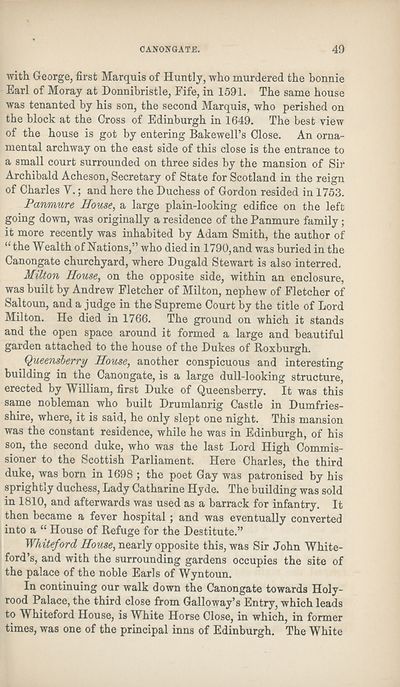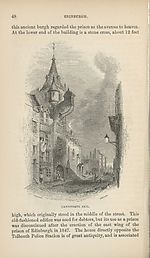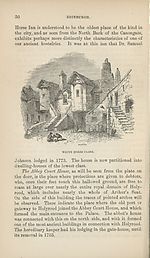Download files
Complete book:
Individual page:
Thumbnail gallery: Grid view | List view

CANONGATE.
49
with George, first Marquis of Huntly, who murdered the bonnie
Earl of Moray at Donnibristle, Fife, in 1591. The same house
was tenanted by his son, the second Marquis, who perished on
the block at the Cross of Edinburgh in 1649. The best view
of the house is got by entering Bakewell’s Close. An orna¬
mental archway on the east side of this close is the entrance to
a small court surrounded on three sides by the mansion of Sir
Archibald Acheson, Secretary of State for Scotland in the reign
of Charles Y.; and here the Duchess of Gordon resided in 1753.
Panmure Home, a large plain-looking edifice on the left
going down, was originally a residence of the Panmure family;
it more recently was inhabited by Adam Smith, the author of
“the Wealth of Nations,” who died in 1790, and was buried in the
Canongate churchyard, where Dugald Stewart is also interred.
Milton House, on the opposite side, within an enclosure,
was built by Andrew Fletcher of Milton, nephew of Fletcher of
Saltoun, and a judge in the Supreme Court by the title of Lord
Milton. He died in 1766. The ground on which it stands
and the open space around it formed a large and beautiful
garden attached to the house of the Dukes of Roxburgh.
Queensberry House, another conspicuous and interesting
building in the Canongate, is a large dull-looking structure,
erected by William, first Duke of Queensberry. It was this
same nobleman who built Drumlanrig Castle in Dumfries¬
shire, where, it is said, he only slept one night. This mansion
was the constant residence, while he was in Edinburgh, of his
son, the second duke, who was the last Lord High Commis¬
sioner to the Scottish Parliament. Here Charles, the third
duke, was born in 1698 ; the poet Gay was patronised by his
sprightly duchess, Lady Catharine Hyde. The building was sold
in 1810, and afterwards was used as a barrack for infantry. It
then became a fever hospital; and was eventually converted
into a “ House of Refuge for the Destitute.”
Whiteford House, nearly opposite this, was Sir John White-
ford’s, and with the surrounding gardens occupies the site of
the palace of the noble Earls of Wyntoun.
In continuing our walk down the Canongate towards Holy-
rood Palace, the third close from Galloway’s Entry, which leads
to Whiteford House, is White Horse Close, in which, in former
times, was one of the principal inns of Edinburgh. The White
49
with George, first Marquis of Huntly, who murdered the bonnie
Earl of Moray at Donnibristle, Fife, in 1591. The same house
was tenanted by his son, the second Marquis, who perished on
the block at the Cross of Edinburgh in 1649. The best view
of the house is got by entering Bakewell’s Close. An orna¬
mental archway on the east side of this close is the entrance to
a small court surrounded on three sides by the mansion of Sir
Archibald Acheson, Secretary of State for Scotland in the reign
of Charles Y.; and here the Duchess of Gordon resided in 1753.
Panmure Home, a large plain-looking edifice on the left
going down, was originally a residence of the Panmure family;
it more recently was inhabited by Adam Smith, the author of
“the Wealth of Nations,” who died in 1790, and was buried in the
Canongate churchyard, where Dugald Stewart is also interred.
Milton House, on the opposite side, within an enclosure,
was built by Andrew Fletcher of Milton, nephew of Fletcher of
Saltoun, and a judge in the Supreme Court by the title of Lord
Milton. He died in 1766. The ground on which it stands
and the open space around it formed a large and beautiful
garden attached to the house of the Dukes of Roxburgh.
Queensberry House, another conspicuous and interesting
building in the Canongate, is a large dull-looking structure,
erected by William, first Duke of Queensberry. It was this
same nobleman who built Drumlanrig Castle in Dumfries¬
shire, where, it is said, he only slept one night. This mansion
was the constant residence, while he was in Edinburgh, of his
son, the second duke, who was the last Lord High Commis¬
sioner to the Scottish Parliament. Here Charles, the third
duke, was born in 1698 ; the poet Gay was patronised by his
sprightly duchess, Lady Catharine Hyde. The building was sold
in 1810, and afterwards was used as a barrack for infantry. It
then became a fever hospital; and was eventually converted
into a “ House of Refuge for the Destitute.”
Whiteford House, nearly opposite this, was Sir John White-
ford’s, and with the surrounding gardens occupies the site of
the palace of the noble Earls of Wyntoun.
In continuing our walk down the Canongate towards Holy-
rood Palace, the third close from Galloway’s Entry, which leads
to Whiteford House, is White Horse Close, in which, in former
times, was one of the principal inns of Edinburgh. The White
Set display mode to:
![]() Universal Viewer |
Universal Viewer | ![]() Mirador |
Large image | Transcription
Mirador |
Large image | Transcription
| Antiquarian books of Scotland > Scotland/Scots > Black's picturesque tourist of Scotland > (101) |
|---|
| Permanent URL | https://digital.nls.uk/130029402 |
|---|
| Description | Thousands of printed books from the Antiquarian Books of Scotland collection which dates from 1641 to the 1980s. The collection consists of 14,800 books which were published in Scotland or have a Scottish connection, e.g. through the author, printer or owner. Subjects covered include sport, education, diseases, adventure, occupations, Jacobites, politics and religion. Among the 29 languages represented are English, Gaelic, Italian, French, Russian and Swedish. |
|---|

